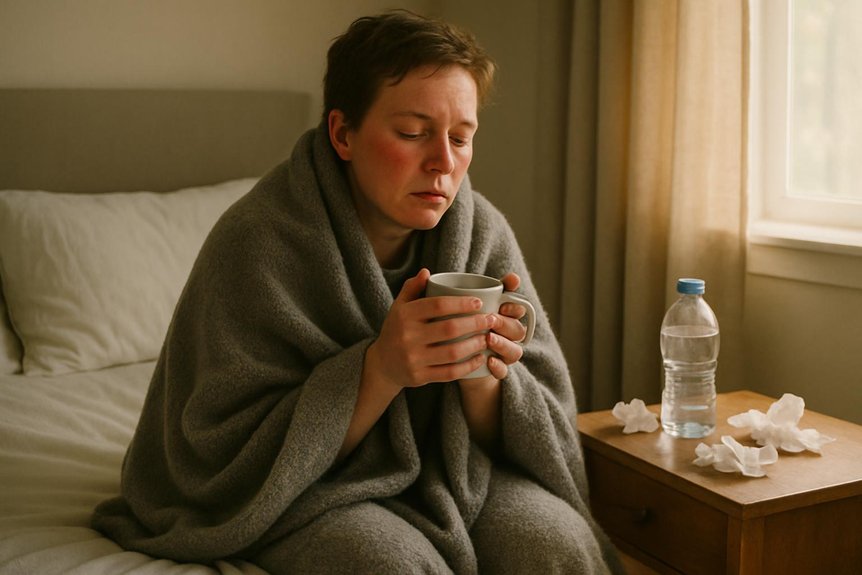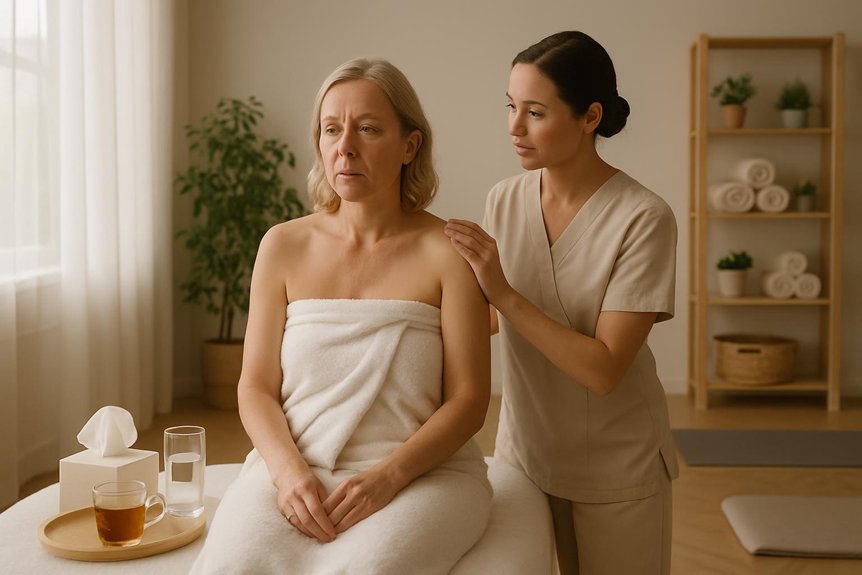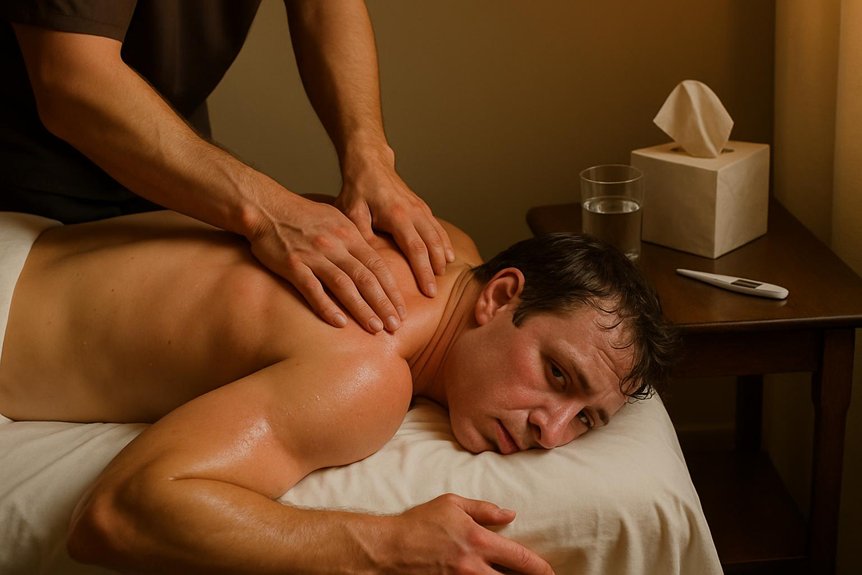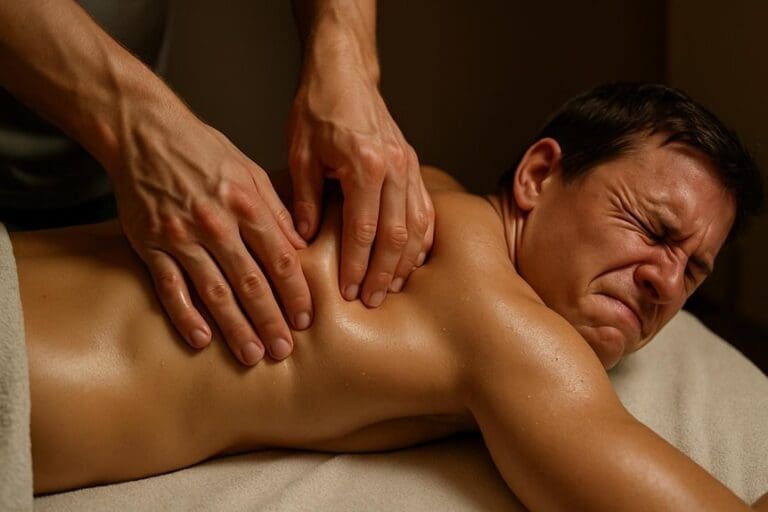It can cause short‑lived, flu‑like sensations such as soreness, fatigue, headache, and mild malaise within 24–48 hours. Firm pressure loads tissues, mobilizes fluids and metabolites, and triggers inflammatory mediators, similar to post-exercise soreness. Hydration, gentle movement, heat, and rest usually help. Seek medical advice for severe, persistent symptoms or red flags (fever, spreading redness, chest pain, numbness, calf swelling). Therapists can minimise discomfort by pacing pressure and calming the nervous system. More context, tips, and precautions follow.
What You May Feel After a Deep Tissue Massage

Following a deep tissue massage, it is common to experience transient soreness, localized tenderness, and mild fatigue within 24–48 hours as tissues adapt to increased pressure and mobilization. Many clients also notice a gentle warmth, slight stiffness on movement, and heightened body awareness. These responses typically settle as circulation improves and muscle tone normalizes.
At Spa & Massage clinics across London, therapists advise hydrating well, pacing activity, and applying brief, cool compresses to tender spots. Then, after 24 hours and if comfortable, gentle heat can be used.
Gentle walking and unhurried stretching help maintain range of motion. Clients may feel quietly grounded, sleep more deeply, or crave extra rest—signs of nervous system downshifting. Should discomfort exceed expected soreness, our team recommends contacting the clinic for tailored guidance and adjustment of pressure in future sessions.
In some settings, incorporating aromatherapy massage techniques can enhance relaxation and support the body’s natural healing process after deep tissue work.
Why Flu-Like Symptoms Can Happen: The Physiology Explained
Although this massage is not “detoxing” in a literal sense, flu-like sensations such as mild achiness, headache, fatigue, or chills can occur as a short-lived physiological response to intensive soft-tissue work.
Mechanistically, firm pressure deforms fascia and muscle, stimulating mechanoreceptors, transiently increasing local inflammation, and altering autonomic tone. This can shift the body into parasympathetic dominance, lowering blood pressure and producing a “heavy,” sleepy calm.
Increased lymphatic and venous return may mobilise interstitial fluid and metabolic by-products, briefly sensitising tissues.
Microtears within tight bands can release inflammatory mediators (e.g., prostaglandins, cytokines) that heighten soreness, similar to delayed-onset muscle tenderness.
At Spa & Massage, therapists calibrate depth gradually, pace breathing, and use targeted myofascial techniques with gentle progressions to minimise overload while honouring the body’s threshold and fostering a grounded, cared-for experience.
Normal After-Effects vs. When to Seek Medical Advice
When this massage is applied appropriately, transient effects such as mild muscle soreness, light fatigue, localized tenderness, slight headache, and temporary thirst are common and typically resolve within 24–48 hours.
Gentle movement, hydration, and warm showers usually ease these sensations. At Spa & Massage, clients are encouraged to rest, sip water, and monitor how their body settles.
Medical advice should be sought if symptoms are disproportionate or persistent: fever above 38°C, escalating pain, spreading redness or warmth suggestive of infection, shortness of breath, chest pain, new numbness or weakness, severe dizziness, or swelling with calf pain.
Individuals on anticoagulants, with clotting disorders, uncontrolled hypertension, recent surgery, or acute illness should contact a clinician if concerns arise. Our therapists document health histories and guide appropriate follow‑up compassionately.
How Our Therapists Minimise Post-Massage Discomfort
A structured approach is used at Spa & Massage to reduce post‑massage discomfort while preserving therapeutic benefit. Therapists begin with a focused intake to identify health history, pressure preferences, and current sensitivities.
They then calibrate depth gradually, warming tissues before targeted work, and modulate techniques—myofascial glides, sustained ischemic pressure, and active release—according to client feedback. In our clinics, hypoallergenic oils with highly effective glide are selected to lessen friction and irritation.
Attention to pacing is central: therapists alternate deeper strokes with integrative, soothing passes to promote parasympathetic balance. They monitor breathing, tone, and tissue response, adjusting in real time to avoid excessive nociceptive input.
Sessions close with gentle down‑regulation, including slower effleurage and diaphragmatic breathing cues, helping clients leave grounded, clear‑headed, and comfortable.
Practical Aftercare: Hydration, Rest, and Gentle Movement
With discomfort minimised during the session, outcomes are reinforced by simple aftercare: adequate hydration, planned rest, and gentle movement.
Spa & Massage advises clients to drink water steadily over the next 12–24 hours to support circulation and normalise tissue metabolism. Herbal teas without caffeine are acceptable. Alcohol and heavy meals are best deferred.
Rest is purposeful: prioritising an early night, warmer layers, and brief screen breaks helps the nervous system settle.
Gentle movement reduces stiffness without reloading tender tissues. Short walks, relaxed spinal mobility, shoulder rolls, and ankle pumps are sufficient.
In our clinics, therapists suggest avoiding high-intensity training for 24–48 hours, then resuming gradually. Warm showers and light self-stretching may soothe residual soreness.
If symptoms escalate or persist beyond 72 hours, clients are encouraged to contact their therapist for tailored advice.
Who Is Most Sensitive and How to Prepare for Your Session

Although intensive tissue massage is well tolerated by most, certain clients are more sensitive and benefit from tailored preparation. Higher sensitivity is common in those new to deep pressure, individuals with high training loads, disrupted sleep, recent illness, dehydration, low iron, or heightened stress.
People with autoimmune conditions, migraines, or a history of post-treatment soreness may also report transient flu-like symptoms.
At Spa & Massage, therapists guide clients to prepare gently: hydrate well the day before and day of treatment, eat a light meal 1–2 hours prior, limit alcohol, and avoid strenuous workouts within 12 hours pre-session.
Communicate medications, pain thresholds, and health changes. Our therapists begin with slower warming strokes, progress pressure gradually, and schedule lighter finishes, with post-session aftercare tailored to recovery goals.
Conclusion
In closing, the article underscores a simple truth: knowledge is the best balm. While this massage therapy can occasionally prompt transient, flu-like sensations, evidence and clinical experience suggest these responses are typically normal and manageable. With clear communication, calibrated pressure, and tailored aftercare—hydration, gentle movement, and rest—clients can reduce discomfort and support recovery. Should symptoms persist or escalate, timely medical advice is prudent. The takeaway is empowerment: informed choices transform short-lived soreness into long-term therapeutic benefit.



